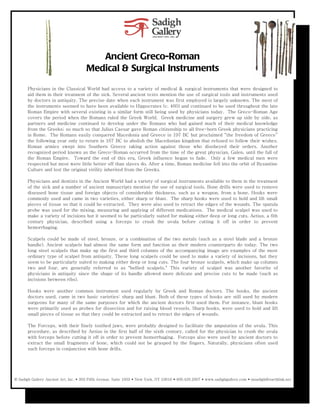Mais conteúdo relacionado
Semelhante a Greco Roman Medical Instruments (20)
Mais de Sadigh Gallery Ancient Art, Inc. (20)
Greco Roman Medical Instruments
- 1. Ancient Greco-Roman
Medical & Surgical Instruments
Physicians in the Classical World had access to a variety of medical & surgical instruments that were designed to
aid them in their treatment of the sick. Several ancient texts mention the use of surgical tools and instruments used
by doctors in antiquity. The precise date when each instrument was first employed is largely unknown. The most of
the instruments seemed to have been available to Hippocrates (c. 460) and continued to be used throughout the late
Roman Empire with several existing in a similar form still being used by physicians today. The Greco-Roman Age
covers the period when the Romans ruled the Greek World. Greek medicine and surgery grew up side by side, as
partners and medicine continued to develop under the Romans who had gained much of their medical knowledge
from the Greeks; so much so that Julius Caesar gave Roman citizenship to all free-born Greek physicians practicing
in Rome. The Romans easily conquered Macedonia and Greece in 197 BC but proclaimed “the freedom of Greece”
the following year only to return in 167 BC to abolish the Macedonian kingdom that refused to follow their wishes.
Roman armies swept into Southern Greece taking action against those who disobeyed their orders. Another
recognized period known as the Greco-Roman occurred from the time of the great physician, Galen, until the fall of
the Roman Empire. Toward the end of this era, Greek influence began to fade. Only a few medical men were
respected but most were little better off than slaves do. After a time, Roman medicine fell into the orbit of Byzantine
Culture and lost the original virility inherited from the Greeks.
Physicians and dentists in the Ancient World had a variety of surgical instruments available to them in the treatment
of the sick and a number of ancient manuscripts mention the use of surgical tools. Bone drills were used to remove
diseased bone tissue and foreign objects of considerable thickness, such as a weapon, from a bone. Hooks were
commonly used and came in two varieties, either sharp or blunt. The sharp hooks were used to hold and lift small
pieces of tissue so that it could be extracted. They were also used to retract the edges of the wounds. The spatula
probe was used for the mixing, measuring and applying of different medications. The medical scalpel was used to
make a variety of incisions but it seemed to be particularly suited for making either deep or long cuts. Aetius, a 6th
century physician, described using a forceps to crush the uvula before cutting it off in order to prevent
hemorrhaging.
Scalpels could be made of steel, bronze, or a combination of the two metals (such as a steel blade and a bronze
handle). Ancient scalpels had almost the same form and function as their modern counterparts do today. The two
long steel scalpels that make up the first and third columns of the accompanying image are examples of the most
ordinary type of scalpel from antiquity. These long scalpels could be used to make a variety of incisions, but they
seem to be particularly suited to making either deep or long cuts. The four bronze scalpels, which make up columns
two and four, are generally referred to as "bellied scalpels." This variety of scalpel was another favorite of
physicians in antiquity since the shape of its handle allowed more delicate and precise cuts to be made (such as
incisions between ribs).
Hooks were another common instrument used regularly by Greek and Roman doctors. The hooks, the ancient
doctors used, came in two basic varieties: sharp and blunt. Both of these types of hooks are still used by modern
surgeons for many of the same purposes for which the ancient doctors first used them. For instance, blunt hooks
were primarily used as probes for dissection and for raising blood vessels. Sharp hooks, were used to hold and lift
small pieces of tissue so that they could be extracted and to retract the edges of wounds.
The Forceps, with their finely toothed jaws, were probably designed to facilitate the amputation of the uvula. This
procedure, as described by Aetius in the first half of the sixth century, called for the physician to crush the uvula
with forceps before cutting it off in order to prevent hemorrhaging. Forceps also were used by ancient doctors to
extract the small fragments of bone, which could not be grasped by the fingers. Naturally, physicians often used
such forceps in conjunction with bone drills.
© Sadigh Gallery Ancient Art, Inc. 303 Fifth Avenue, Suite 1603 New York, NY 10016 800.426.2007 www.sadighgallery.com msadigh@earthlink.net
- 2. Bone drills were generally driven in their rotary motion by means of a thong in various configurations. Greek and
Roman physicians used bone drills in order to excise diseased bone tissue from the skull and to remove foreign
objects of considerable thickness (such as a weapon) from a bone.
Physicians in the Classical World employed catheters in order to open up a blocked urinary tract, which allowed
urine to pass freely from the body. These early catheters were essentially hollow tubes made of steel or bronze and
had two basic designs: one with a slight S curve for male patients and another straighter one for females. The same
doctors also used similar shaped devices, which were solid, as opposed to hollow, in order to probe the bladder in
search of calcifications.
© Sadigh Gallery Ancient Art, Inc. 303 Fifth Avenue, Suite 1603 New York, NY 10016 800.426.2007 www.sadighgallery.com msadigh@earthlink.net

